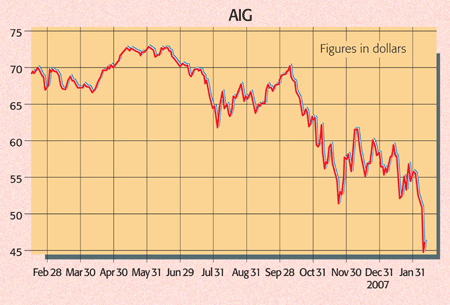Subprime rot is starting to spread
G7 finance chiefs announced that subprime write-offs could reach $400bn, so where is all that bad debt hiding? Japanese banks will have to come clean by the end of March, but Europe may in fact be a likelier candidate for subprime mayhem.
Even after an atrocious month for markets in January, the grim reality that faces the global economy appears to be only slowly dawning on investors.
A brief attempt at a rally at the start of February was swiftly crushed by data suggesting that the US services sector was shrinking for the first time in five years.
Since then, the news has continued to get worse. Investors were rattled when the world's largest insurer, American International Group (AIG) suddenly announced that it was raising its estimate of losses from insuring mortgage-related instruments from $1bn to nearly $5bn. The warning came after the group's auditor, PricewaterhouseCoopers, said it had found a "material weakness" in the way the group calculated the value of its sub-prime mortgage investments. In August, AIG had described its sub-prime exposure as "minimal".
MoneyWeek
Subscribe to MoneyWeek today and get your first six magazine issues absolutely FREE

Sign up to Money Morning
Don't miss the latest investment and personal finances news, market analysis, plus money-saving tips with our free twice-daily newsletter
Don't miss the latest investment and personal finances news, market analysis, plus money-saving tips with our free twice-daily newsletter

AIG wasn't the only one revising its sub-prime estimates. G7 finance chiefs announced that they now believe that subprime write-offs are likely to stack up to $400bn far more than the $120bn that has already been admitted to by banks so far. So where is the bad debt hiding? Some fear that Japanese lenders notoriously reluctant to come forward and lose face by admitting their losses are the ones holding the biggest chunk of dodgy debt.
The iTraxx Japan index measuring the default risk of 50 Japanese companies had its biggest one-day leap ever on Thursday, with Japanese banks leading the way, which could be "a serious distress signal" that Japan will be the source of the nastiest surprises, says Ambrose Evans-Pritchard in The Daily Telegraph. Investors will soon find out as the country's audit code decrees that Japanese banks have to come clean by the end of the tax year in March.
But Europe may in fact be a more likely candidate for new subprime mayhem. The European Central Bank has been falling over itself to lend banks money since the crisis started, and has also been allowing them to put up asset-backed paper which is very likely to include sub-prime mortgage exposure as collateral. Brussels is facing the very real prospect that it still has to write-down several hundred billion in debts from European banks riddled with subprime exposure.
In fact, according to John Mauldin in the Frontline Weekly Newsletter, there are serious rumours that one of the largest European banks is technically in negative equity due to the massive amount of asset-backed paper on its books, which has not yet been written down.
Meanwhile, at the root of the problem, the US housing market shows no signs of improving. In fact, the subprime rot is already spreading to near-prime and prime mortgages, notes Nouriel Roubin on Rgemonitor.com. He estimates that about 60% of all mortgages given since 2005 have been offered on the basis of the reckless practices no downpayments or proof of income that are at the root of the subprime mess.
The Mortgage Bankers Association reports that default rates on all outstanding home loans in the US have hit 7.3%, the highest since records began in the 1970s. Arrears on prime mortgages a market worth around $8,000bn are now standing at 4%. And as William Sels of Dresdner Kleinwort tells Evans-Pritchard, "the crisis is not going to stop at mortgages. It is spreading to credit card debt, auto debt and now student loans." And tighter credit conditions around the globe mean that "there are very similar problems emerging in Britain, Ireland and Spain".
This could go on for sometime. Deleveraging' is the natural end result of the bursting of the credit bubble, says Edward Hadas on Breakingviews. The consequence will be lower asset prices and lower economic activity. "Whatever the government and central banks do, the deleveraging snowball will reach the bottom of the mountain it could be a long and painful wait" until then.
Get the latest financial news, insights and expert analysis from our award-winning MoneyWeek team, to help you understand what really matters when it comes to your finances.
MoneyWeek is written by a team of experienced and award-winning journalists, plus expert columnists. As well as daily digital news and features, MoneyWeek also publishes a weekly magazine, covering investing and personal finance. From share tips, pensions, gold to practical investment tips - we provide a round-up to help you make money and keep it.
-
 How cancelling unused direct debits could boost your pension by £37,000
How cancelling unused direct debits could boost your pension by £37,000A new year refresh of your spending could save you money and help boost your pension pot.
-
 NS&I cuts interest rates on 8 savings accounts
NS&I cuts interest rates on 8 savings accountsNS&I will now offer less attractive interest rates for customers wishing to lock their savings away to grow for one, two, three or five years.

